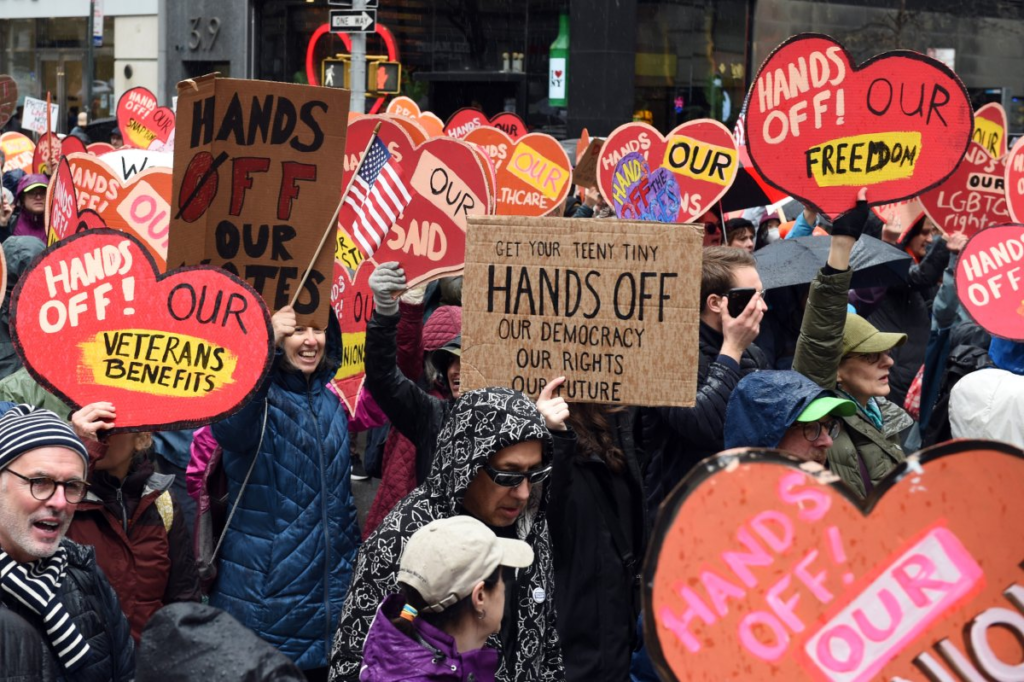Nationwide ‘Hands Off!’ Protests Target Trump and Musk
Table of Contents

On April 5, 2025, the United States witnessed a remarkable display of public dissent as over 1,200 protests erupted across all 50 states under the banner of the “Hands Off!” movement. From the bustling streets of Chicago and New York to the sunlit avenues of Los Angeles and from the historic corners of Boston to the quieter roads of Providence, thousands of Americans gathered to voice their opposition to President Donald Trump and billionaire Elon Musk.
These protests, marking one of the largest single-day mobilizations in recent history, were a visceral response to the administration’s policies, particularly those affecting social programs like Social Security, Medicare, and Medicaid. As the nation grapples with a rapidly shifting political landscape, the “Hands Off!” protests signal a growing resistance to what many perceive as an overreach of power and a threat to foundational American values.
The Spark of the “Hands Off!” Movement
The “Hands Off!” movement emerged as a grassroots coalition, uniting diverse groups—civil rights advocates, labor unions, veterans, environmentalists, and everyday citizens—around a shared sense of urgency. The protests were meticulously organized by over 150 advocacy organizations, including prominent names like Indivisible, the ACLU, and Planned Parenthood, reflecting a broad spectrum of concerns.
At the heart of the demonstrations was a rejection of the Trump administration’s aggressive policy shifts, many of which have been accelerated by Elon Musk’s influential role as head of the newly created Department of Government Efficiency (DOGE). Musk, a close ally of Trump, has spearheaded efforts to downsize the federal government, slashing jobs and funding in what he claims is a bid to save taxpayers billions. However, protesters argue that these cuts disproportionately harm vulnerable populations and dismantle critical social safety nets.
The timing of the protests, just months into Trump’s second term, underscores the speed and scale of the administration’s actions. Since his inauguration on January 20, 2025, Trump has issued a flurry of executive orders targeting federal agencies, immigration, and economic policy.
Coupled with Musk’s DOGE initiatives—which have already eliminated over 200,000 federal jobs—these moves have ignited widespread alarm. The “Hands Off!” rallies, held on April 5, were a clarion call to halt what organizers describe as a “hostile takeover” of American democracy by billionaires and political elites.

A Nationwide Outcry
The sheer scope of the protests was staggering. From the National Mall in Washington, D.C., where over 20,000 people rallied near the Washington Monument, to smaller gatherings in rural towns, the message was unified: “Hands off our rights, our resources, and our democracy.”
In Chicago, thousands braved rainy conditions to march through the Loop, their signs decrying cuts to Social Security and healthcare. New York saw demonstrators flood Bryant Park and Fifth Avenue, chanting slogans like “Unplug Elon” and “Hands off our future.” Los Angeles hosted a vibrant rally near City Hall, while Boston’s protest on the Common drew a mix of students, retirees, and veterans. Even in Providence, Rhode Island, a state often overlooked in national narratives, hundreds gathered to echo the nationwide sentiment.
The protests weren’t confined to urban centers or liberal strongholds. In conservative states like Texas and North Carolina, demonstrators turned out in force, proving that the discontent transcends traditional political divides. In Houston, marchers rallied against immigration crackdowns, while in Charlotte, attendees highlighted threats to education and reproductive rights. Across the board, participants expressed a shared fear that the administration’s policies favor the ultra-wealthy at the expense of working families.
Targeting Trump and Musk
Donald Trump and Elon Musk emerged as the twin focal points of the protests, their names emblazoned on signs and shouted in chants. Trump, whose return to the presidency has been marked by bold and controversial moves, faced criticism for policies ranging from mass deportation plans to the rollback of climate regulations.
His April 1 announcement of sweeping tariffs sent shockwaves through the economy, prompting a stock market plunge and further fueling public unrest. Protesters accused him of prioritizing personal grievances and corporate interests over the public good, with one sign in Washington, D.C., reading, “No King Trump.”
Elon Musk, meanwhile, has become a lightning rod for outrage due to his outsized influence in the administration. As head of DOGE, Musk has overseen drastic reductions in federal staffing and funding, including the closure of Social Security offices and cuts to veterans’ services. His justification—that such measures are necessary to avert national bankruptcy—has done little to quell the anger of those who see his actions as an attack on essential programs. In cities like San Francisco and Ann Arbor, where Tesla dealerships have faced prior protests, demonstrators targeted Musk’s corporate empire, linking his wealth and influence to the erosion of democratic norms.

The Stakes: Social Programs Under Siege
At the core of the “Hands Off!” protests was a fierce defense of social programs like Social Security, Medicare, and Medicaid. These initiatives, long considered pillars of American society, have come under threat as the administration seeks to streamline government operations.
While the White House insists that Trump will protect these programs for “eligible beneficiaries,” critics point to concrete actions—such as the closure of dozens of Social Security offices and the elimination of thousands of related jobs—as evidence of a broader dismantling effort. Protesters, including retirees like Roger Broom of Ohio and veterans like Colleen Boland of D.C., argued that such cuts jeopardize the livelihoods of millions.
Medicare and Medicaid, too, have faced scrutiny, with proposed reductions in funding sparking fears of diminished healthcare access. In St. Paul, Minnesota, demonstrators waved signs reading “Hands off our healthcare,” while in Sacramento, California, ralliers decried the potential loss of school meal programs and consumer protections. The message was clear: these programs are not mere budgetary line items but lifelines for the most vulnerable Americans.
Beyond Borders: A Global Echo
The “Hands Off!” movement resonated beyond U.S. borders, with solidarity protests popping up in cities like London, Paris, Berlin, and Frankfurt. American expatriates and local supporters gathered to denounce Trump and Musk’s policies, often tying them to broader concerns about authoritarianism and corporate overreach. In London’s Trafalgar Square, demonstrators waved signs reading “Hands off democracy,” while in Paris, marchers linked the U.S.
protests to global fights for social justice. This international dimension highlighted the stakes of the moment, with organizers framing the administration’s actions as a challenge not just to America but to democratic values worldwide.

A Movement in Motion
As the sun set on April 5, 2025, the “Hands Off!” protests left an indelible mark on the national consciousness. Organizers hailed the day as a success, with estimates of participation ranging from 250,000 to over 500,000 nationwide. Yet, they emphasized that this was just the beginning. “We can’t just outnumber them,” said Rachel Carmona of the Women’s March at the D.C. rally. “We have to outlast them and out-organize them.” For many, the protests were a reclaiming of “people power,” a reminder that collective action can challenge even the most entrenched forces.
The White House, for its part, remained defiant. Press officials reiterated Trump’s commitment to efficiency and taxpayer savings, dismissing the protests as misguided. But as the echoes of “Hands off!” reverberate, it’s clear that the administration faces a formidable opposition—one that spans generations, geographies, and ideologies. Whether this movement can alter the course of Trump and Musk’s agenda remains to be seen, but on April 5, 2025, the American people made their voices heard loud and clear.



